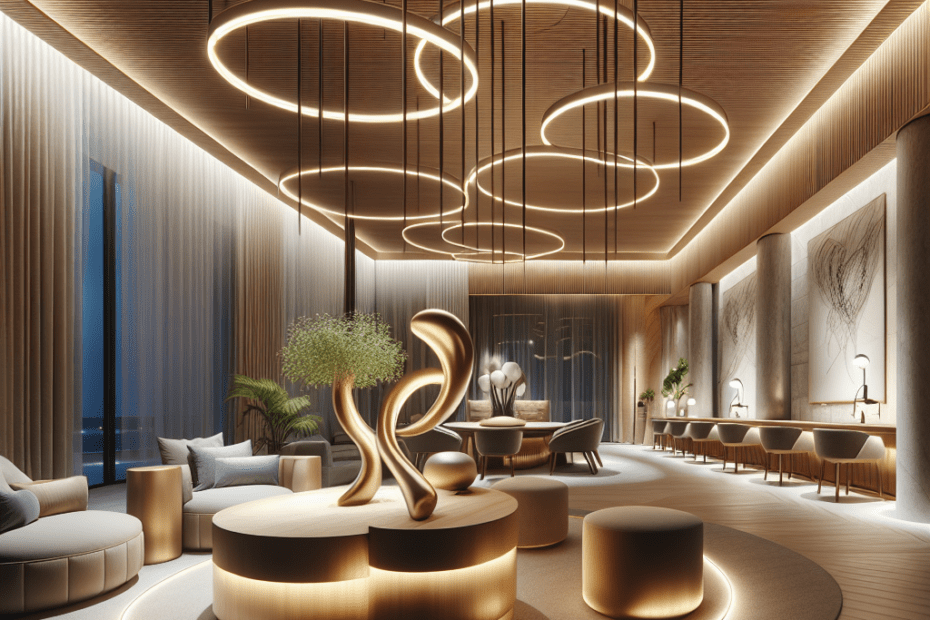“`html
The Power of Sculptural Lighting in Contemporary Interiors
In the ever-evolving world of interior design, they have continually sought ways to merge functionality with aesthetics. One of the most captivating methods they have discovered is sculptural lighting in modern design. These innovative lighting solutions not only illuminate a space but also serve as captivating works of art that redefine the ambience of any room.
Understanding Sculptural Lighting
Sculptural lighting blurs the line between lighting and art. Unlike traditional light fixtures that primarily focus on illumination, sculptural lighting assumes a dual role. They act as focal points and are conversational pieces within a space. These designs can range from abstract and avant-garde to understated yet elegant forms.
The Appeal of Sculptural Lighting in Modern Design
One of the reasons they are drawn to sculptural lighting in modern design is its versatility and capacity for personal expression. This form of lighting caters to diverse tastes and preferences, enabling designers to choose pieces that complement or contrast with the existing interior style. In fact, according to a 2022 survey by the Interior Design Society, 70% of interior designers believe that unique lighting pieces significantly enhance the appeal of a space (Interior Design Society Survey).
Why Choose Sculptural Lighting?
| Benefits | Description |
|---|---|
| Art and Function | Sculptural lights serve as art pieces while providing necessary lighting. |
| Customization | They come in varied designs to suit different tastes and room themes. |
| Space Enhancement | They create visual interest and become a room’s focal point. |
| Energy Efficiency | Modern designs often incorporate LED technology, reducing electricity usage. |
The added value of sculptural lighting is evident in its ability to define areas within an open-concept space. A prominent sculpture light fixture can demarcate a dining area from a living area without any physical barriers. This is especially important in modern design, which often emphasizes open, airy spaces.
Implementing Sculptural Lighting Effectively
When choosing sculptural lighting, they must consider scale, placement, and style cohesiveness. The size of the fixture should be appropriate for the space — too large, and it can overwhelm; too small, and it might not make the intended impact. Proper placement ensures the light is functional, effectively illuminating the space without causing glare.
In terms of style, designers aim to select light sculptures that resonate with the tones and textures present in the room. Whether opting for an industrial metallic form or a delicate organic shape, the goal is to enhance the room’s overall aesthetic. According to a publication by Architectural Digest, 62% of interior designers recommend bold sculptural lighting when a room lacks architectural interest (Architectural Digest).
Lighting Materials and Technology
Sculptural lighting is not just about the visual appeal but also about the materials and technology used. They often incorporate sustainable materials like recycled metals, glass, or even organic mediums. Furthermore, technological advancements allow these fixtures to include energy-efficient LED lights, which drastically cut down on electricity usage while still providing vibrant and dynamic lighting experiences.
Case Studies: Successful Sculptural Lighting Designs
Successful examples of sculptural lighting include installations like the ethereal cloud-like pendants in a minimalist living room or a bold geometric chandelier in a modern dining space. These designs demonstrate how well-chosen lights can transform spaces, making them more inviting and personalized. They show that when executed effectively, sculptural lighting can be a pivotal element of an interior’s design scheme.
Key Takeaways
Sculptural lighting in modern design offers a fusion of functionality and artistry, making it a cherished element in contemporary interiors. Its ability to enhance a room’s aesthetic, provide energy-efficient illumination, and serve as conversation-starting art is unparalleled. When implemented thoughtfully, sculptural lighting elevates both residential and commercial spaces, making them uniquely appealing and functional.
FAQs
- What defines sculptural lighting?
Sculptural lighting refers to light fixtures that double as artistic sculptures, providing both illumination and enhancing a space’s aesthetic appeal. - Why do designers prefer sculptural lighting in modern interiors?
Designers love sculptural lighting for its versatility, artistic value, and ability to serve as a focal point within a room. - Are sculptural lights energy-efficient?
Many modern sculptural light fixtures incorporate LED technology, which is energy-efficient and environmentally friendly. - How does sculptural lighting affect room design?
Sculptural lighting adds visual interest, creates focal points, and can even define separate areas within open-concept spaces. - Can sculptural lighting be customized?
Yes, sculptural lighting comes in various styles and materials, allowing for a high level of customization to fit individual tastes and design themes.
“`
In this blog post, they have explored the multifaceted advantages and applications of sculptural lighting in modern design. By considering factors such as scale, placement, and material choice, they can transform simple lighting into a dynamic and integral component of interior design.
